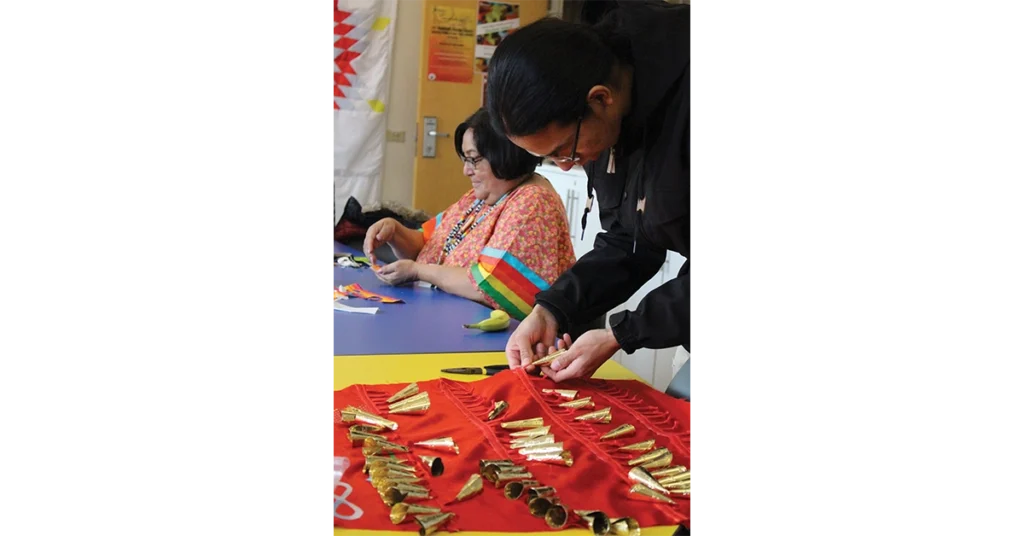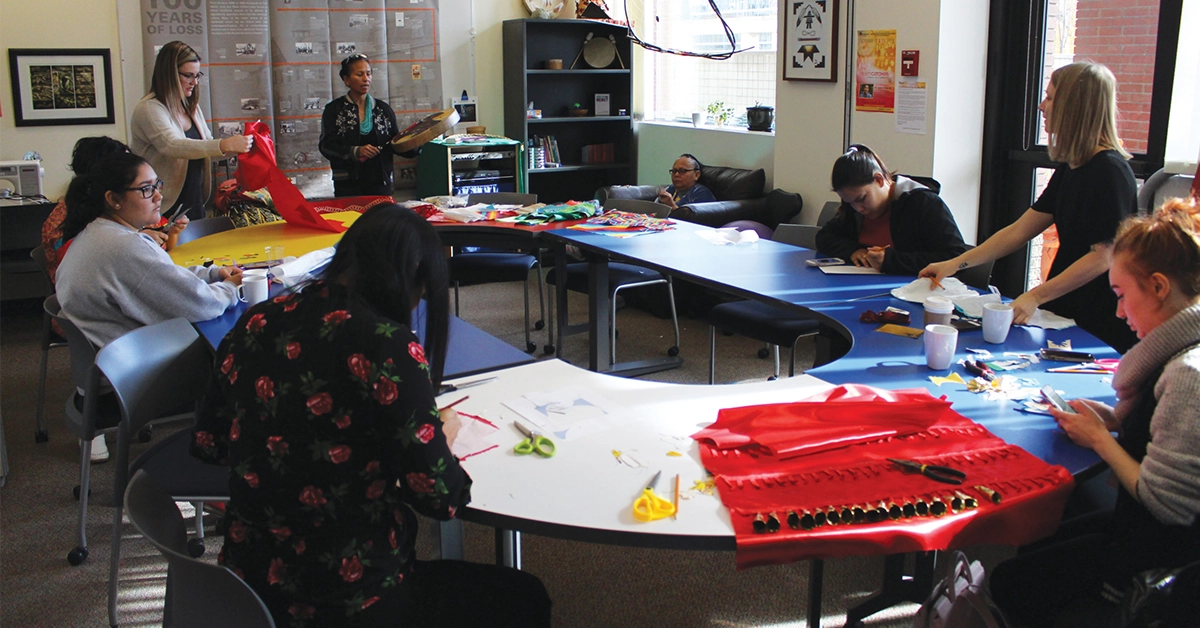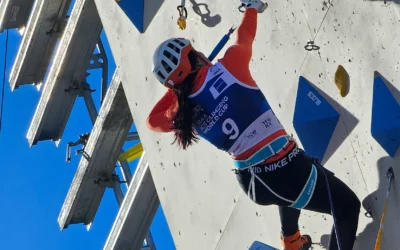Oct. 1-5 marked MacEwan University’s second annual Sexual Violence Awareness Week. Oct. 4 is also the day set aside to honour Missing and Murdered Indigenous Women and Girls. As part of Sexual Violence Awareness Week, and in honour of Missing and Murdered Indigenous Women and Girls, MacEwan hosted a jingle dress creation.
The event aimed to bring people together to design and construct a community jingle dress. Attendees all worked together to create the dress by adding jingles — small metal cylinders that jingle when the dress moves. Once the dress was completed, it was worn and danced in, in honour of and in dedication to the Missing and Murdered Indigenous Women and Girls.
According to a 2014 report by the Royal Canadian Mounted Police (RCMP), nearly 1,200 Indigenous women were missing and/or murdered between 1980 and 2012. However, Indigenous women’s groups place the number at over 4,000. The disparity in the numbers is often chalked up to the under-reporting of violence against Indigenous women and girls and the lack of an effective database, as well as the failure to identify such cases by ethnicity.
Indigenous women in Canada are seven times more likely to become the victims of homicide than non-Indigenous women. They are also 3.5 times more likely to experience violence than non-Indigenous women.

Roslyn Cardinal, Administrative and Communications Coordinator, kihêw waciston, and Sexual Violence Support Guide, has personal ties to both the issue and the Jingle Dress Creation event.
“In 1970, my Aunt Stella was 19 years old and six months pregnant. One day, she went out into the bush with people she knew and just disappeared,” Cardinal states in an article on MacEwan’s website.
She goes on to explain, “When my family went to the police for help, not much was done. The police did look for a bit, but didn’t communicate with my family — they just heard rumours about the case. It was officially ruled a death with no foul play, but her body was never found. It was treated like a non-issue.”
Cardinal says that when the National Inquiry into Missing and Murdered Indigenous Women and Girls visited Yellowknife last year, her Aunt Freda told her sister Stella’s story. Freda continues to speak on her sister’s behalf and wants her voice be heard and acknowledged.
“That’s what this day is about — creating a voice for the women and families who have not been able to tell their stories. It’s really important to shed light on this issue — not only on the facts, but on how we can prevent this from continuing,” says Cardinal. “It’s been going on for way too long. We need to challenge the idea that Indigenous people don’t matter. We all have to come together to move forward. This isn’t a women’s issue. It isn’t an Indigenous issue. It’s everyone’s issue.”
Amnesty International came out with a report in 2004 titled, Stolen Sisters: A Human Rights Response to Discrimination and Violence Against Indigenous Women in Canada. The report sought not only to identify that there was in fact systemic discrimination against Indigenous Women, and that this put them at increased risk of violence, but also the causes behind this phenomena.
- The report focused on four factors, “which, too long neglected, have contributed to a heightened — and unacceptable — risk of violence against Indigenous women in Canadian cities.” These factors were:“The social and economic marginalisation of Indigenous women, along with a history of government policies that have torn apart Indigenous families and communities, have pushed a disproportionate number of Indigenous women into dangerous situations that include extreme poverty, homelessness and prostitution.
- Despite assurances to the contrary, police in Canada have often failed to provide Indigenous women with an adequate standard of protection.
- The resulting vulnerability of Indigenous women has been exploited by Indigenous and non- Indigenous men to carry out acts of extreme brutality against them.
- These acts of violence may be motivated by racism, or may be carried out in the expectation that societal indifference to the welfare and safety of Indigenous women will allow the perpetrators to escape justice.”
The report also questioned the response of Canadian law enforcement and the Canadian Justice system to the cases of Missing and Murdered Indigenous Women and Girls in Canada.
It states, “both the perpetrators of violence against women and those who administer the criminal justice system — judges, prosecutors, police — often hold the pervasive view that women are responsible for violence committed against them or that they deserve to be punished for non-conforming behaviour.”
Within the nine case studies examined by Amnesty International, they found incidents where police failed to take basic steps, such as “interviewing family and friends or appealing to the public for information,” when family members of a missing Indigenous woman expressed concern that she was in serious danger. “These steps are particularly urgent when the missing person is a girl, as the State has special obligations to find and protect children at risk,” they note.
In addition, the report reminds the Canadian government of the obligations all governments have to human rights standards under international law, which is: “governments are of course obliged to ensure that their own officials comply with human rights standards. Governments are also obliged, though, to adopt effective measures to guard against private individuals committing acts which result in human rights abuses.”
Stolen Sisters states that it would be beyond the scope of the report to examine all of the governmental policies that have impacted Indigenous peoples and put Indigenous women at risk. However, they do recognize, “two historic policies — the dispossession of Indigenous women who married outside their communities and the removal of children to be educated in residential schools — need to be examined because of their profound and lasting impact on social strife within Indigenous communities and on the marginalization of Indigenous women within Canadian society.”
At the end of the report, Amnesty International also included six recommendations for the Canadian government, in hopes that they would address the grim findings of the report and the issue at large. The six recommendations are:
“1) Acknowledge the seriousness of the problem
2) Support research into the extent and causes of violence against Indigenous women
3) Take immediate action to protect women at greatest risk
4) Provide training and resources for police to make prevention of violence against Indigenous women a genuine priority
5) Address the social and Economic factors that lead to Indigenous women’s extreme vulnerability to violence
6) End the marginalization on Indigenous women in Canadian Society”
The Stolen Sisters report came out in 2004. However, it wasn’t until late 2013 that the commissioner of the RCMP initiated a study of the reported incidents of missing and murdered aboriginal women.
The study was led by the RCMP and would study only incidents in which official reports were filed. The Government of Canada didn’t launch an independent National Inquiry into Missing and Murdered Indigenous Women and Girls until September 2016.
The creation of a community jingle dress was not the only event that was held as part of Sexual Violence Awareness week in relation to the Missing and Murdered Indigenous Women and Girls day at MacEwan. It is, however, particularly significant when one looks at the Ojibwe history of jingle dress dancing.
According to Dr. Brenda J. Child’s addition to the book Reflections on American Indian History: Honoring the Past, Building a Future, “The jingle dress is an Ojibwe tradition that began in the early 20th century, but one with enduring significance. Ojibwe people associate the jingle dress with therapeutic rituals that support physical and spiritual healing.”
In the chapter that she contributed to the book, Child goes on to describe the story of the origins of the jingle dress that she learned at Red Lake. The story is that during World War I, an Ojibwe girl became very ill, possibly with the widespread Spanish influenza.
When her father feared he was going to lose her, he sought a vision to save his daughter. In his vision, he saw the dress and the instructions for the dance and went about putting together the dress.
When it was finished, he asked her to do a few springlike steps in which she always kept one foot on the ground, like those unique to the steps he had seen in his vision. As she danced, the girl started feeling better and continued dancing. Eventually she recovered completely, and would come to form the first Jingle Dress Dance Society.
While this is only one story about the origins of Jingle Dress Dancing, it does highlight what the jingle dress represents: the important role of Indigenous women in Indigenous forms of healing. This not only conveys the traditional and irreplaceable role of Indigenous women in society, but also adds a level of significance to MacEwan’s choice to hold a Jingle Dress Creation in honour of Missing and Murdered Indigenous Women and Girls, an issue that arguably requires widespread societal, spiritual, and physical healing.
The MacEwan Creating a Voice events page states, “This day is an act of solidarity and support, honouring those missing and murdered, and their families.”
Photography by Milo Knauer.





0 Comments